Guest Editors Kathleen O’Neal Gear and W. Michael Gear
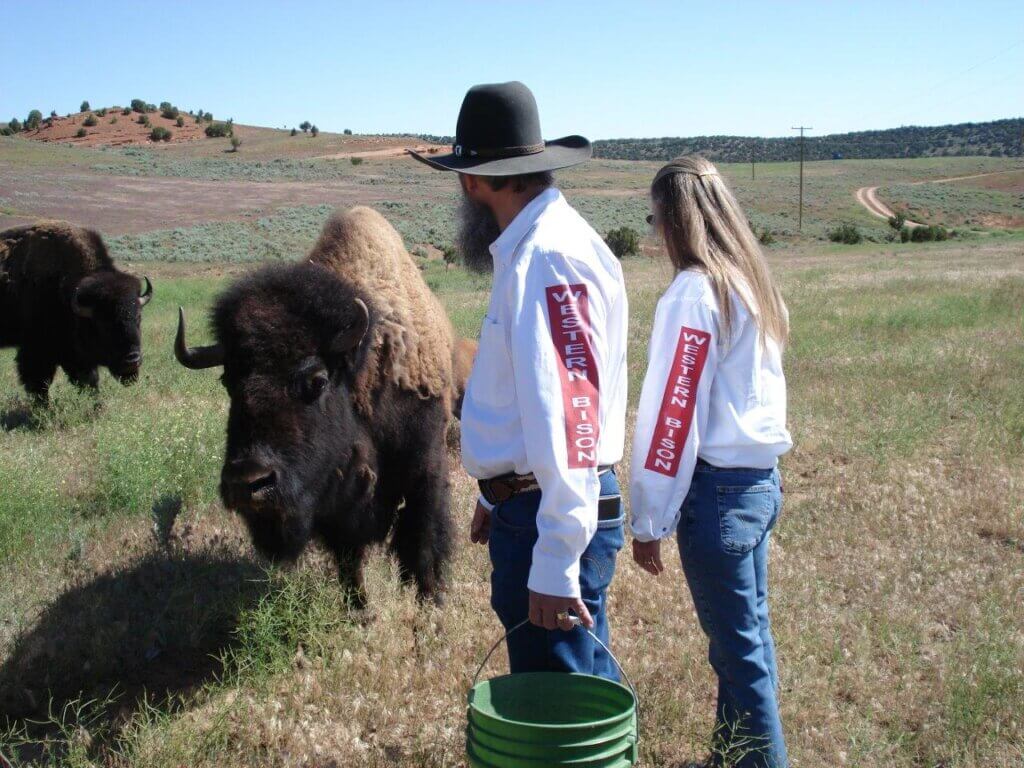
Mike and Kathy Gear with Pia, their first bottle-baby. Courtesy the authors.
Bison, better known as buffalo, played a vital role in the history of the West. The native peoples considered them to be sacred and magical animals. Some early explorers and ranchers felt the same way.
Since we’ve been living with bison for the past 25 years, we wanted to share a few of our experiences with you. Those experiences have informed our writing, but they’ve also helped us to understand bison’s iconic status in the early West.
It’s 7 on a cold May morning in 2002, and we’re out checking the buffalo when we notice a cow lying alone by the electric fence.
We pull out the binoculars to see the cow’s number. It’s #411, a cow named Little Mother. She was in labor last night, but we do not see a calf beside her. We drive forward slowly, looking for that telltale glimpse of orange fur in the tall grass.
As we get closer, we see the newborn bull calf stretched over the bottom wire of the fence. The hot wire. He’s clearly dead. Little Mother just won’t leave him.
We always have a veterinary inspection done of animals that die on the ranch, so we’re going to wait until Little Mother leaves, collect the calf and take him to our excellent vet in Worland, Wyoming.
It will turn out that the bull calf died shortly after birth when he apparently stumbled over the hot wire and the millisecond pulse stopped his heart—the first and only time this has happened.
But this is not the story of a dead calf. It’s the story of the herd’s behavior in the hours after we found Little Mother.
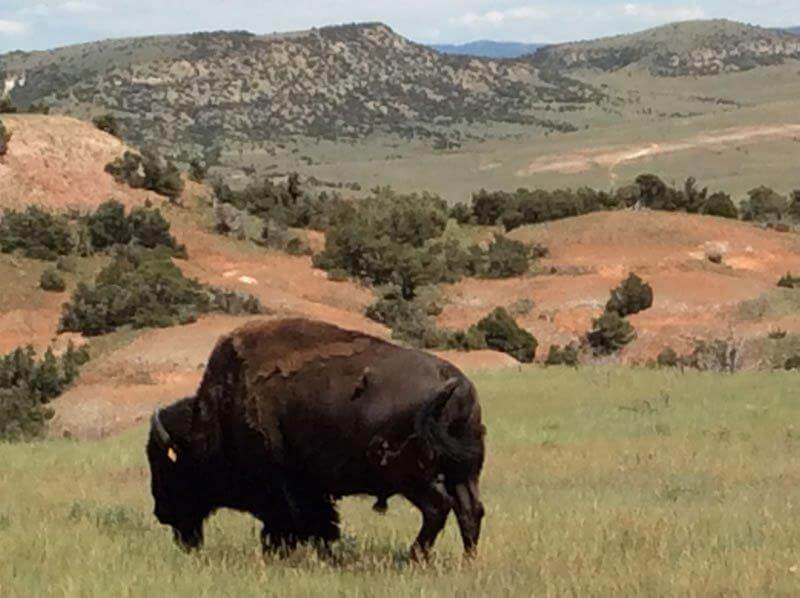
Bison Bull on Red Canyon Ranch, Themopolis, Wyoming. Courtesy of authors.
About 20 minutes after we turned off the truck engine and poured cups of coffee from the thermos, Little Mother’s best friend, Sister Crazy Horse, separated from the herd and came over to lie down beside her.
Sister Crazy Horse gently licked Little Mother’s ears, looked at the dead calf and stretched her neck over Little Mother’s back, where she stayed for several minutes.
A little while later, two more cows left the main herd and came to joining Sister Crazy Horse. They took turns licking Little Mother.
At one point, Sister Crazy Horse got up and went to the fence to nudge the dead calf with her nose. When it didn’t move, she returned to lick Little Mother.
Over the next hour the rest of the herd gradually moved closer, until it stood about 100 yards away from the four cows by the dead calf.
At last Little Mother got up and walked a short distance away to graze. The three other cows went with her, leaving us our chance to drive over, block their views with the truck and pull the calf off the fence. We loaded him in the back of the truck and started to drive away.
But we stopped about an eighth of a mile down the road. The cows had suddenly noticed the calf was gone. Little Mother charged back and began sniffing around, clearly looking for him, running up and down the fence.
Sister Crazy Horse and four other cows trotted over to join her in the search. They all sniffed along the fence.
After about five minutes Little Mother dropped beside the fence in the exact place where she’d been earlier, but Sister Crazy Horse and four cows joined together to run headlong up the fence line, calling and calling.
Bison make a deep-throated rumble and many other sounds. They were making a very distinctive bison call, the call of a mother cow searching for her calf.
We watched them run all the way to the fence corner about a mile away before they charged back, calling constantly, and surrounded Little Mother again.
A buffalo conversation ensued, the cows talking softly to one another for around 10 minutes. It took another 30 minutes before the four cows started to wander away from Little Mother, and we headed to the vet clinic.
When we returned Little Mother was still there by the fence. It took two days before she fully left the place where her calf had been killed.
Why? Was Little Mother heart-broken?
When the calf’s body disappeared, did Sister Crazy Horse lead a group of friends in a frantic search for a calf that she assumed had risen and wandered off?
That’s what it looked like.
But is that what happened?
We have to be careful not to engage in “anthropomorphizing,” the human tendency to attribute human emotions to animals when they do not exist.
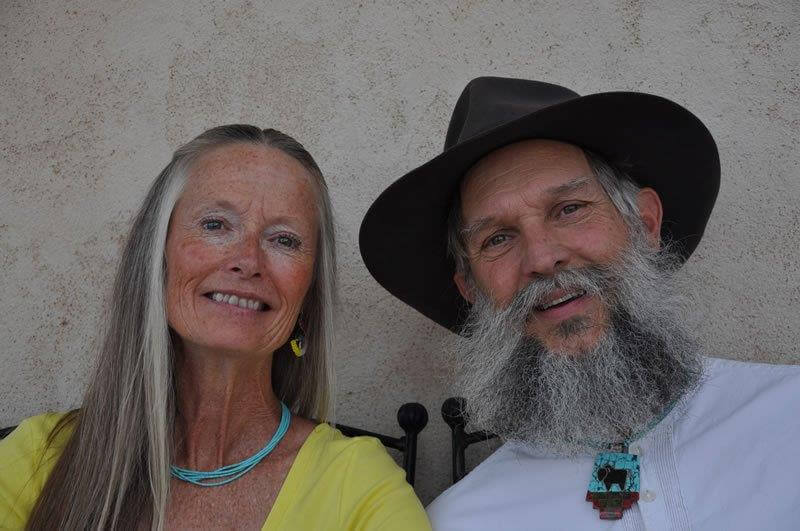
Kathleen and W. Michael Gear, Wyoming Archeologists, have raised bison for 25 years. They caution people about “anthropomorphizing”—the human tendency to attribute human emotions to animals when they do not exist. Courtesy of authors.
As anthropologist Barbara King from the College of William & Mary notes in her excellent book, How Animals Grieve:
“Occasionally the pull of anthropomorphism may overwhelm scientists’ normal caution in reporting animal responses to death.”
The problem of course is that our culture suffers from The Bambi Syndrome. We see the Bambi Syndrome in children’s movies and especially books for children, in which animals are portrayed as talking in human voices, laughing, singing and traipsing off on mythic adventures packed together in automobiles.
In fact, we live in terror that someday we’ll see a children’s book with bison riding off into the sunset on motorcycles singing “Oh, Happy Day!”
The lessons taught by such books and movies are disturbing because they lead children to believe that animals feel and think exactly as we do, which seems unlikely.
The truth is that interpreting animal behavior is a challenge. Not all animal responses to death are the same and scientists can be overly enthusiastic when it comes to assigning reasons for behavior.
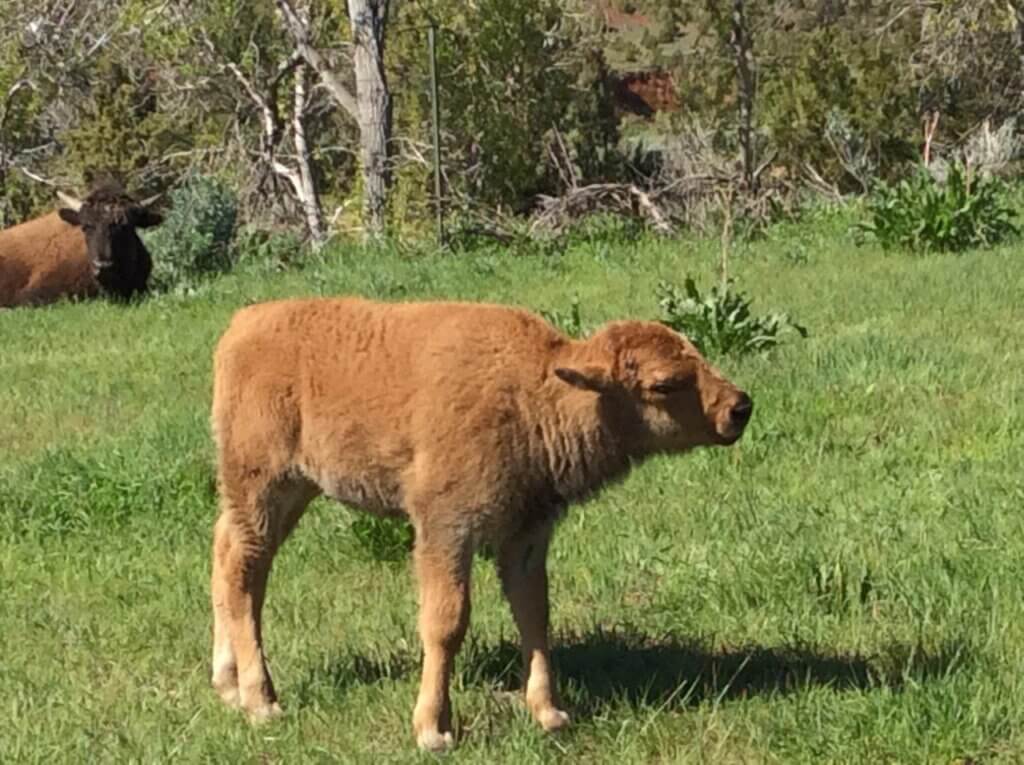
Beautiful bison calf at Red Canyon Ranch. Courtesy of authors.
For example, in 2014 Dr. Teresa Iglesias from the University of California at Davis published an article in the journal Animal Behavior titled:
“Western scrub jay funerals: cacophonous aggregations in response to dead conspecifics.”
In the article Iglesias noes that scrub jays flock around dead companions and vocalize—they call to each other raucously.
Is that really a funeral? No caregiving rituals were involved, at least not that a human could determine. Were the jays merely noting the death and warning each other that danger might be nearby? Or was the flocking and vocalizing an expression of grief at the death of a loved companion?
In her book Through a Window, anthropologist Jane Goodall documents the heart-wrenching story of Flint, a young chimpanzee who refused to eat after the death of his mother.
Flint declined and died, apparently from grief.
Other examples noted by King are instructive: “. . . when Eleanor, the dying matriarch of an elephant family, collapsed, a matriarch named Grace from another family immediately came to her aid, using her tusks to support Eleanor back onto her feet.
“When Eleanor fell again, Grace stayed with her, pushing on her body for at least an hour, even though her own family moved on.
“Then Eleanor died. During the course of the week that followed, females from five elephant families, including Eleanor’s own, showed a keen interest in the body. Some individuals appeared upset, pulling at or nudging the body with trunk and feet or rocking back and forth while standing over it.”
It has been well documented that elephants return over and over for years to caress the bones of dead matriarchs.
Also herds of giraffes guard the body of dead infants to protect them from scavengers while they apparently mourn with the mother, and ducks lay their heads on the bodies of dead companions.
King notes another interesting example. In 2015 on a research vessel off the coast of Greece, researchers watched a bottlenose dolphin pushing her dead infant away from the observer’s boat, apparently protecting it from the boat.
Over and over again she pushed the calf with her snout and pectoral fins. As the baby’s body swelled in the hot sun and began to decay, the mother continued to care for the corpse by removing pieces of dead skin and loose flesh.
The other dolphins, about 50, approached to watch but didn’t disturb the mother, who refused to eat for two days while she “cared” for her dead infant.
Are these examples of profound mourning over the deaths of loved ones? What is a “death ritual” when it comes to animals? Can such rituals be identified?
Let us give you one last example: A few years ago our oldest cow, Lange, died at the age of 26. We had done everything we could for her but to no avail. The vet said her heart was failing.
Lange had a warm personality. By all criteria that humans can determine, she was apparently loved by her herd.
When she lay down for the last time, her youngest daughter, Susie Q and her best friend Clover were with her. Susie Q and Clover often moved a short distance away to graze, but continually returned throughout the morning to check on Lange and lick her.
When it was clear that Lange wasn’t getting up again, we drove out, blocked the herd’s view with the truck and ended her struggle. When we drove away Susie Q was the first to come back to the body. She licked her mother all over, then Clover did the same thing.
As the day progressed every member of the herd came to lick Lange’s body and graze beside her. Watching them had a profound, even arresting, impact on us.
At sunset, when they seemed to be finished caring for Lange the herd started to move away, and we went out with the tractor to pick her up and take her to another pasture. Lange’s coat was completely clean of every spot of blood and bodily fluids and covered with tongue marks from intensive licking.
As we carried her away the herd followed us. They were quiet. Unusually quiet. If we were describing human behavior we’d call it deep mourning. That stunned silence you feel when you know someone you love is gone forever.
Susie Q and Clover stayed together for three days, separated from the herd, grazing side-by-side before they rejoined the herd.
Did we witness a buffalo funeral? At the risk of sounding “overly enthusiastic,” our answer is maybe. At worst we’re doing the animals a disservice by misunderstanding their behavior. It’s difficult to define grief in another species.
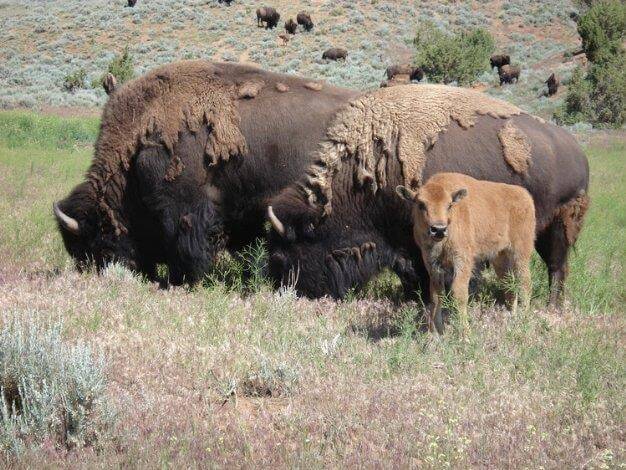
Bison family group at Red Canyon Ranch. Courtesy of the authors.
What are the scientific criteria? How should we determine them?
Most scientists agree on a two-part definition: “First, the animals in question should ‘choose to spend time together beyond survival-oriented behaviors;’ and second, ‘when one animal dies, the survivor alters his or her normal behavioral routine.’” (Nancy Lambert, Scientific American, June 25, 2013).
Though much of bison behavior remains a mystery, it seems clear to us that their responses to the death of a member of the herd meet that definition.
Buffalo love and they grieve—which was undoubtedly noted long ago by the earliest inhabitants of the Western frontier.
Sources
Batdorff, Allison. “Bison ranch owners swap animal tales,” Billings (Montana) Gazette, Jun 3, 2005.
King, Barbara. How Animals Grieve. Chicago: University of Chicago Press, 2014.
Lambert, Nancy. When Doves Cry: Scientific American Explores Grief in Animals,” Tor.com, June 25, 2013.
Reprinted from Western Writers of America Roundup Magazine, Apr 2020. Michael and Kathleen Gear, Guest Editors, are Wyoming Archeologists and writers. For more
information visit the following:



